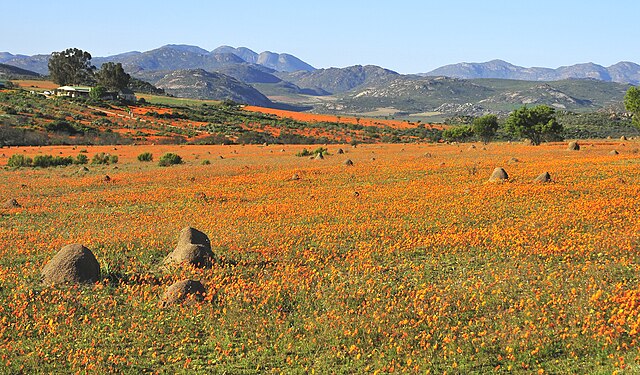 Thanks to their penchant for eating the wood of houses and businesses, termites are not the most beloved insects.
Thanks to their penchant for eating the wood of houses and businesses, termites are not the most beloved insects.
However, the colonies they build are both incredible in size and complexity and vital for sequestering carbon.
Recently, the oldest termite colony in the world was discovered in South Africa, and researchers have been studying its effects on the environment.
Background on the Colony
In Namaqualand, a desert scrubland along the Buffels River in South Africa, about 27% of the landscape is dotted with tiny sandy hills that the locals call "heuweltjies", which means “little hills” in Afrikaans.
 This area houses a massive colony of southern harvester termites (Microhodotermes Viator). In 2021, researchers wanted to investigate the mysterious salinity of the area’s groundwater, so they used radiocarbon dating to identify when the minerals seeped into the water from the mounds. What they found was that the extensive termite colony was about 34,000 years old, shattering the previous record of 4,000 years.
This area houses a massive colony of southern harvester termites (Microhodotermes Viator). In 2021, researchers wanted to investigate the mysterious salinity of the area’s groundwater, so they used radiocarbon dating to identify when the minerals seeped into the water from the mounds. What they found was that the extensive termite colony was about 34,000 years old, shattering the previous record of 4,000 years.
Termite colonies, particularly this ancient one, are massive, intricate structures with temperature control, security, and a complex maze of tunnels, making them a subject of interest among researchers. Even more fascinating, however, is the impact the colony has on its environment.
Role of the Colony in the Ecosystem
Patches of spring flowers grow on these termite mounds, despite the dry and inhospitable landscape. This is also thanks to termites, which break down and excrete nutrients that enrich the soil around their colonies.
When it rains, the tunnels act as channels for water and dissolved nutrients to flow deep into the ground, explaining the salinity of the groundwater. The presence of termites and their massive colonies makes semiarid landscapes more resilient to drought and climate change.
Even more vital is the role of termites in sequestering carbon. Termites collect plant matter, like twigs and dead plants, and bring it deep underground, where decomposers can’t turn it into carbon dioxide as much as on the surface. Instead, the carbon in this matter is stored for thousands of years, some of it being calcified by microbes to act as both further protection for the colony against diggers like aardvarks, and long-term carbon storage.
The calcium carbonate is dissolved into the underground reservoirs during periods of heavy rain, rendering the water undrinkable, but acting as an effective carbon sink. It is estimated that each termite mound in Namaqualand colony stores about 15 tons of carbon!
Researchers are continuing to explore the intricacies of termite colonies and their role in combating climate change, but the Namaqualand colony has made one fact apparent; termites are key to making arid lands like the African Savanna, grasslands, and woodlands more resilient to future droughts and global warming.
Sources: NY Times, Nature, Utexas.edu, The Conversation








